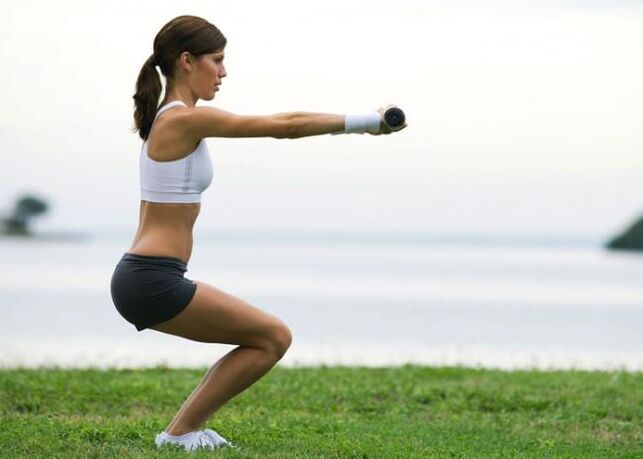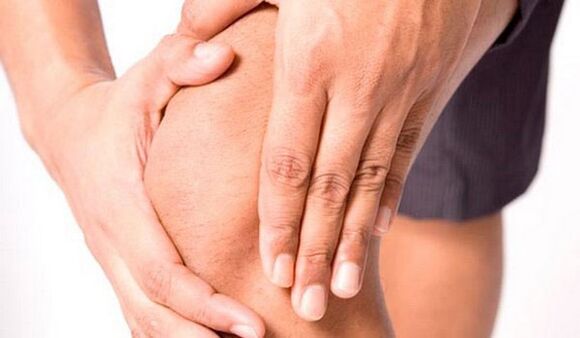The joints of a person's lower extremities are responsible for the free and active movement of the body in space. Therefore, the appearance of even minor walking problems leads to a noticeable loss of mobility.
More than half of all joint diseases occur in the knees as one of the largest articular joints that can withstand the load of the entire human body.
The main causes of knee pain
All diseases in which the knee is injured can be divided into several groups depending on the predominant mechanism of joint damage:
- Inflammatory processes in the joints (arthritis) and periarticular sac (bursitis). With arthritis, the knee joints increase in size, cracking when bent. General well-being deteriorates, body temperature rises. Bursitis is characterized by the presence of a rounded extension in the wrist area, which is an accumulation of fluid. The cause of inflammatory diseases lies in the penetration of the infection into the joints (through wounds, cuts, foci of internal infection).
- Degenerative lesions of the wrist - osteoarthritis. In this case, for a long time there is a gradual destruction of the inner articular surfaces, excessive growth of bone tissue. As the load on the knee continues to exist, the destroyed joint does not have time to recover and collapses even more. Osteoarthritis is characterized by initial pain, i. e. in the morning or after a long rest, the knees ache when bending and walking. The pain goes away after squats or other stress on the joints. Patients with osteoarthritis of the knee joints in advanced stages notice difficulty in climbing and descending stairs, the appearance of pain even at rest.
- Traumatic consequences - intra-articular fractures, bruising, dislocations and sprains. For any kind of joint damage, it is advisable to contact a specialist who will decide what to do - immobilize the joint or, conversely, give it a functional load.
Causes of knee joint pain in pregnant women
Knee pain during pregnancy is explained by a sharp load added to the joints of the lower extremities due to weight gain due to the uterus, fetus and amniotic fluid. In addition, in the last trimester, many people experience abnormal fluid retention (edema) and weight gain, which also creates excessive pressure on the legs and impedes the normal functioning of the knee joints.
In the last weeks of pregnancy and during childbirth, there is a powerful production of relaxing substances that soften the articular ligaments. Thanks to relaxation, the ligaments of the pelvic joints are mainly stretched, but other joints, including the knee, can also be affected.
With all of these conditions, pregnant women have pain in the knee joints both at rest and at night. Within a few weeks after giving birth, a woman leaves the body with excess water, the production of relaxation stops, the weight is reduced, so the discomfort in the knees disappears.
Causes of pain during sports
When running and playing "walking" sports (volleyball, tennis, football), the knee joint experiences much greater stress than when walking. The fluid produced in the joints for its normal functioning does not have time to form in sufficient quantities, and therefore the friction of the articular surfaces increases.

In the presence of knee injuries in the past, ankle degradation under the influence of sport can progress rapidly. If after a workout (especially after running or jumping) there is pain in the knee joint, it does not mean that you should give up the sport at all. You just have to review the options for loading the knees and replace the sport or group of exercises with a softer one for the legs.
Causes of knee pain in children
The most common cause of knee pain in a child is an injury that occurs due to excessive physical activity. Bruising can be suspected by the appearance of the knee - there is bruising and scratching on the skin, swelling on the side of the stroke.
If a child complains of knee pain, infectious arthritis, which usually occurs shortly after a worsening of another bacterial infection (tonsillitis, otitis media, bronchitis) or viral, should be ruled out. With such arthritis, the joint looks red, swollen, the general condition of the child worsens - the body temperature rises, lethargy appears, drowsiness.
Another cause of knee disease in children can be autoimmune arthritis (rheumatoid arthritis). In this case, in addition to the knees, the child will be involved in the inflammatory process and the elbows, as well as the small joints of the fingers. This type of arthritis is characterized by the "instability" of the lesion - within a short time, the inflammation passes from one joint to another.
Treatment and prevention of knee pain
Scheduling treatment for the knee joint should be handled by a specialist who after examination will discover why the knee hurts and how to treat this case. Treatment of pain in the knee joints aims to reduce inflammation and degenerative processes. To do this, all patients with knee pathology are recommended:
- limit physical load on joints (including refusal to carry weights, climbing stairs); women are advised not to wear heels, because due to improper redistribution of body weight increases pressure on the joints. In some cases (complex dislocations), it is required to completely immobilize the knee with the help of a splint or plaster;
- take a course of chondroprotectors - preparations that contain substances necessary for the structure of the joints (chondroitin sulfate and glucosamine). Chondroprotectors are prescribed for oral use in the form of tablets as well as externally as part of ointments and gels. In a hospital, it is also possible for these substances to be injected directly into the knee joint;
- use painkillers, anti-inflammatory drugs (corticosteroid hormones and nonsteroidal anti-inflammatory drugs) and antibacterial agents;
- outside the irritation phase, undergo a course of physiotherapeutic procedures (clay applications, ultrasound treatment and electrophoresis);
- load the affected node correctly - with the help of therapeutic exercises. One of the best such exercises is "bicycle" - in the supine position, imitate the pedal flow of a bicycle.
- in extremely advanced degenerative processes in the joint, surgical knee arthroplasty is preferred.

Treatment of joints with folk remedies
In addition to traditional methods of treating sore knees, folk remedies for relieving inflammation are also effective in many cases:
Lotions with ammonia-camphor solution
Mix half a glass of ammonia (10% solution) with 10 g of camphor alcohol, add 1 liter of salted water (for this you need 1 tablespoon of salt per liter), shake until the sediment disappears. Heat the solution to a warm temperature in a water bath, soak gauze in it and apply to the sore knee. Top with polyethylene. Keep up to half an hour, 2-3 times a day.
Cabbage leaf compress
Beat a fresh cabbage leaf with a hammer, sprinkle lightly with salt so that the cabbage starts to get juicy. Apply on the knees for a few hours, fixing it with a bandage. Another variant of this compress is the application of a thin layer of honey on a cabbage leaf, otherwise the procedure is the same.
Lens paper tincture
100 g of dry stalks insist for 3 weeks per 1 liter of vodka. Take by mouth half an hour before a meal, 1 tbsp. l. , diluted in 50 ml of water. The tincture can be rubbed into the injured knee or made into lotions.
Ointment from beeswax
A piece of wax the size of a matchbox, egg yolk and honey (1 tablespoon. L) Mix everything in a water bath, apply with a swab to the sore joint overnight.
Folk methods, as well as therapeutic exercises, should be agreed with the attending physician, because out of ignorance a person can easily harm themselves (for example, when using bee products from the outside in a patient with an allergic disease or when trying to develop ajoints deployed with physical exercises).
Prevention of diseases of the knee joints is aimed at preventing the entry of infection in them (timely treatment of chronic inflammatory foci), reducing the load (fighting excess weight, wearing fixative bandages) and strengthening the ligament apparatus of the jointsand bone (gymnastics, swimming, cycling, drinking while eating calcium-rich foods).
Remember that good and timely treatment of the knees, as well as prevention of injuries and recurrence of joint diseases, will allow you to maintain active mobility for many years.






















